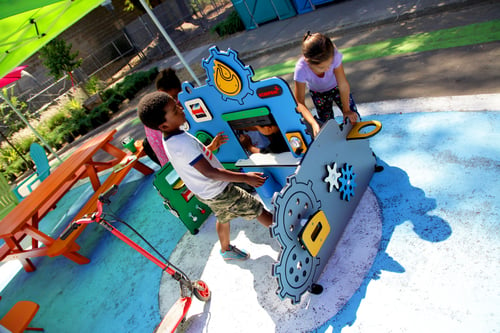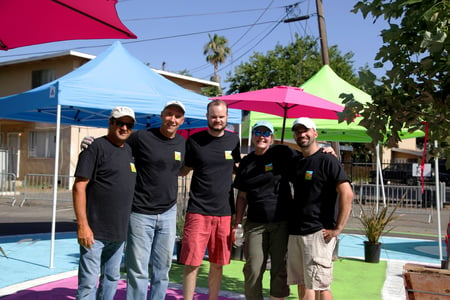How Tactical Urbanism Benefits Communities
 When it comes to sustainable design, green spaces like community parks provide great value. Sustainable landscape design complements buildings and cityscapes, softens the urban environment, improves the atmosphere and provides welcome gathering areas for people to enjoy. Earlier this month, LPA joined the California Sierra Chapter of the American Society of Landscape Architects (ASLA) and Sacramento community groups and municipalities to build a one-day pop-up park in the heart of downtown Sacramento. The 44th Ave Pop-Up, as it was named, was designed to bring awareness to a street safety and beautification improvement project for this vibrant, developing community.
When it comes to sustainable design, green spaces like community parks provide great value. Sustainable landscape design complements buildings and cityscapes, softens the urban environment, improves the atmosphere and provides welcome gathering areas for people to enjoy. Earlier this month, LPA joined the California Sierra Chapter of the American Society of Landscape Architects (ASLA) and Sacramento community groups and municipalities to build a one-day pop-up park in the heart of downtown Sacramento. The 44th Ave Pop-Up, as it was named, was designed to bring awareness to a street safety and beautification improvement project for this vibrant, developing community.
The cul-de-sac on 44th Ave and 39th Ave has been a notorious area for crime, dumping and other unwanted activities. It is also the entrance to a pedestrian bridge that more than 250 children use to get to and from school each day. The construction project emphasizes lighting, restricting access to off-limits areas and an improved aesthetic. The ASLA partnered with County Supervisor Patrick Kennedy and his staff, Southgate Recreation and Parks District, Sacramento County Department of Transportation, CalTrans, nearby Pacific Elementary School and the Franklin Neighborhood Development Corporation to create a fun, colorful oasis in the street and bring quality public space to an area with none.
The project takes an approach known as “tactical urbanism,” which responds to the variety of challenges cities face in an ever-shifting social, political, cultural and economic climate. Even the simplest projects can seem to take millions of dollars and years to complete. The oftentimes long, bureaucratic and expensive process of transforming public space usually mean only the highest profile projects survive. The small, and sometimes most impactful projects, can fall to the wayside. Tactical urbanism shows the power of short-term, community-based projects like pop-up parks and how they can be a useful tool in the path to restoring access to quality public space and influencing policy. These small quick parks can often have profound and lasting effects within the community and government.
 The event was a huge hit—more than 200 members from the community showed up to eat free food, play games and relax in the shade of pop-up tents. For the afternoon, the ASLA converted the cul-de-sac by painting the street bright colors and bringing in colorful pop-up tents, Adirondack chairs, umbrellas, picnic tables, a play structure and more than 600 boxed trees and plants. A local resident brought his guitar and played a few tunes for a small gathering. Another took a peaceful snooze in the comfort of a shaded chair. The children played games, swung hula-hoops, chased balls and did arts and crafts provided by the Southgate R.E.C. Van. They also lined up to take turns twirling in a ground spinner, or to get their face painted.
The event was a huge hit—more than 200 members from the community showed up to eat free food, play games and relax in the shade of pop-up tents. For the afternoon, the ASLA converted the cul-de-sac by painting the street bright colors and bringing in colorful pop-up tents, Adirondack chairs, umbrellas, picnic tables, a play structure and more than 600 boxed trees and plants. A local resident brought his guitar and played a few tunes for a small gathering. Another took a peaceful snooze in the comfort of a shaded chair. The children played games, swung hula-hoops, chased balls and did arts and crafts provided by the Southgate R.E.C. Van. They also lined up to take turns twirling in a ground spinner, or to get their face painted.
Children decorated paper cut-outs of “ribbons” which we hung on the tail of a giant kite hanging on the back fence. The kite and ribbons were collected by Sacramento County with the intent of incorporating it as a permanent public art piece along a wall which will be constructed in the cul-de-sac. We had a great response from the local residents—especially the kids. We even had about 20 kids help us paint the street on Saturday, and then come out early Sunday morning to help set up. All the neighbors said they were glad we did this for the community and hoped we will come back soon. I hope we will too.
Andrew is a Landscape Architect in LPA’s Sacramento office and Vice President of the California Sierra ASLA. He is a LEED accredited professional who specializes in K-12 School design.